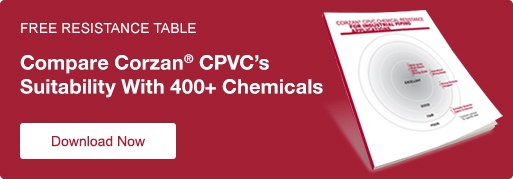Corzan® CPVC: The Industry Standard
It was an old boiler that exploded, devastating three floors and the building’s roof at the Grover Shoe Factory in Brockton, Massachusetts, on March 10, 1905 (ASME.org). The unthinkable tragedy resulted in 58 deaths and 117 injuries. This gave rise to the Board of Boilers Rules, Boiler Code Committee of 1911, and to the eventual publication of the Boiler & Pressure Vessel Code (BPVC) in 1915.
Our industry continues to strive for better standards to address design, application, and inspection of metallic and non-metallic systems. Lubrizol is a responsible company that contributes to many of these standards organizations, participating in code and standards meetings and working with industry leaders to help keep workers safe and protect our communities.
Standards help companies like Lubrizol understand acceptable practices and apply the correct material to the correct application in our production designs. At the heart of selecting the appropriate piping system is chemical resistance. In industrial processes, chemistry principles are at work every minute of every day. One of the basic truths in chemistry is “like dissolves like.” Thus, inorganic metals are more susceptible to corrosion through contact with other inorganic substances like water, brines, acids, caustics, and oxidizers.
Lubrizol’s advanced materials unit, once known as BFGoodrich, invented CPVC. Since pioneering the chlorination process safely, the company has built a track record for Corzan® CPVC compounds that spans over 60 years and billions of feet of piping installed globally. Why? Besides the fact that this piping is chemically inert, engineers have found the fundamental physical properties of the material provide the right solution for a diverse set of project applications and industry sectors.
The Smart Specification For These Ten Applications
Corzan CPVC pipe is pressure rated for operations up to 200°F (93°C) such as sanitation/disinfection and pretreatment and can be relied upon to maintain its pressure-bearing capabilities for the design life of the system. In these scenarios, the greatest lifecycle benefit accrues when the specification calls for Corzan CPVC with process piping carrying the ten most commonly used chemicals in industry.
So if it has been a long time between reviews, 2021 may be the year for an updated specification to include Corzan CPVC for secondary piping that is vulnerable to corrosion or needs to preserve the integrity and cleanliness of the process stream where the ten chemicals are used:
- Sodium hypochlorite (NaOCl). Common use: household bleach, at 5% chlorine concentration
- Sodium hydroxide (NaOH). Common use: also known as caustic soda, an ingredient in drain and oven cleaners
- Hydrochloric acid (HCl). Common use: tile cleaners, toilet bowl cleaners
- Sulfuric acid (H2SO4). Common use: battery acid, tile cleaners, toilet bowl cleaners
- Phosphoric acid (H3PO4). Common use: rust removers, fertilizers
- Sodium chloride (NaCl). One of the most abundant minerals on earth, salt
- Chlorine dioxide (ClO2). Common use: disinfection of drinking water
- Nitric acid (HNO3). Common use: fertilizer
- Hydrogen peroxide (H2O2). Common use: oral antiseptic
- Last but certainly not least, water (H2O). In addition to regular chlorinated water, this includes reverse osmosis water, deionized (DI), demineralized, ozonated, wastewater, lab-grade water, and cooling, chiller, and condenser water.
Corzan CPVC has become the industry standard, the go-to material for replacing metallic systems that corrode in DI water systems or erode in the presence of sodium hypochlorite. The industry segments that benefit are many, as shown by the applications below:
- Commercial Construction: potable water. Corrosion resistance and multiple joining methods are the driving force behind the industry moving to Corzan CPVC systems. The cost-effective value proposition brings longer life expectancy along with safe fire performance. Corzan CPVC is a standard material of construction for potable water, Hydronics, HVAC, and specialty water supplies.
- Water Treatment: municipal water supply. Corzan Piping Systems are key in the purification and delivery of clean potable water to millions of people around the world. Corzan CPVC’s ability to meet NSF 61 and its chemical resistance to chlorine dioxide, sodium hydroxide, sodium hypochlorite, and chloramines provides a clean, corrosion-free system.
- Data Centers: HVAC, cooling systems. Corzan CPVC’s ability to deliver in primary and double containment options results in a lightweight, corrosion-free, quiet piping system for the data center industry. The incorporation of mechanical joining systems provides even more connectivity options. Combining these benefits with the fire-safe plenum rating makes Corzan CPVC the material of choice for this evolving industry.
- Chemical Processing: chemical feeds. Corzan CPVC’s 400+ tested chemicals list provides a wide range of applications to help the chemical processing industry produce on time and on spec products for consumers.
- Mineral Processing: metal extraction. The extraction of rare earth metals through the mineral processing industry is one of many that has seen Corzan CPVC provide solutions to their corrosion issues. Corrosion resistance at elevated temperatures is a key reason why metallurgists choose Corzan CPVC.
- Power Generation: water and venting application. Corzan CPVC has found a home in the pretreatment (softening) of supply water as well as boiler feed systems that need higher purity clean process water. In addition, many treatment chemicals can be handled by this versatile technology.
- Food and Beverage: process feed and cleaning systems, reagent processes, air scrubbing, and water treatment.
- Pulp and Paper: primary and secondary water treatment, scrubbers, desalination, and process feed systems.
- Semiconductor: process cooling, chemical feed and recovery, lithographic plate etching, and scrubber systems. In addition, tool hook-up ventilation systems, potable water, and CMP water systems are very common uses.
- Chlor-Alkali: anolyte, catholyte, sodium hydroxide, sodium hypochlorite, hydrochloric acid, and sulfuric acid feed and recovery systems.
As the inventor and manufacturer of Corzan CPVC compounds, Lubrizol has tested hundreds of different chemicals to confirm their suitability for contact with CPVC. In addition, Corzan Piping Systems field support teams work closely with both pipe manufacturing partners and project teams to provide consulting and technical assistance to ensure a successful installation.


